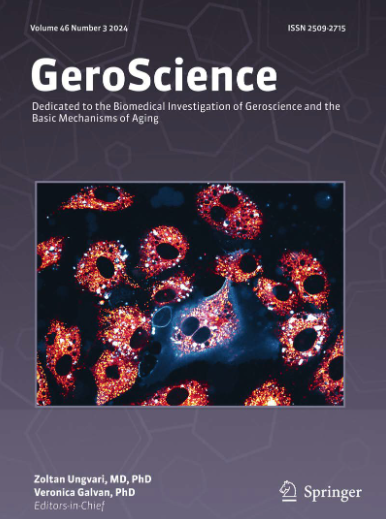The association of thigh myosteatosis with lower cognitive function in older cancer survivors.
IF 5.4
2区 医学
Q1 GERIATRICS & GERONTOLOGY
引用次数: 0
Abstract
INTRODUCTION Cancer is associated with accelerated aging, including changes in muscle composition and cognition. However, the relationship between myosteatosis and cognitive function has not been investigated in older cancer survivors. This study evaluated the association between myosteatosis and cognitive function in this population. METHODS The sample included 75 cancer survivors (age 76-85; 65% men; 31% Black; 41% prostate cancer; 21% breast cancer) from the Health ABC study who developed cancer within the first five years, completed CT imaging at Year 6, and cognitive testing at Year 10. Thigh intermuscular fat area (myosteatosis) was measured by CT at Year 6. Cognitive function was assessed using the Digit Symbol Substitution Test (DSST) and Modified Mini-Mental Status Exam (3MS) at Years 5 and 10. Multivariable models adjusted for demographics, education, cognitive function, and thigh muscle area at Year 5. Sensitivity analyses adjusted for leg strength, race, dementia risk factors, BMI, abdominal visceral fat, and thigh subcutaneous fat. LASSO regression identified key predictors of DSST and 3MS scores. RESULTS Greater thigh myosteatosis at Year 6 was associated with lower DSST (B = - 0.212, p < 0.05) and 3MS (B = - 0.145, p < 0.05) scores at Year 10. Associations remained significant after adjustment for strength, dementia risk, and adiposity. LASSO identified race, education, Year 5 cognition, and myosteatosis as key predictors for DSST as well as thigh muscle area and physical activity for 3MS. DISCUSSION Thigh myosteatosis is independently associated with lower cognitive performance in older cancer survivors and may represent a rehabilitation target to improve cognitive outcomes.老年癌症幸存者大腿肌骨化症与认知功能低下的关系。
癌症与加速衰老有关,包括肌肉成分和认知的变化。然而,骨化病与认知功能之间的关系尚未在老年癌症幸存者中进行研究。本研究评估了该人群中肌骨化病与认知功能之间的关系。方法样本包括75名癌症幸存者(年龄76-85岁,65%男性,31%黑人,41%前列腺癌,21%乳腺癌),来自健康ABC研究,他们在前五年内患上癌症,在第6年完成CT成像,在第10年完成认知测试。第6年用CT测量大腿肌间脂肪区(肌骨化症)。在5年级和10年级使用数字符号替代测试(DSST)和改进的迷你精神状态测试(3MS)评估认知功能。多变量模型调整人口统计,教育,认知功能,大腿肌肉面积在五年级。敏感性分析调整了腿部力量、种族、痴呆危险因素、BMI、腹部内脏脂肪和大腿皮下脂肪。LASSO回归确定了DSST和3MS评分的关键预测因子。结果6年较大的大腿肌骨化症与10年较低的DSST (B = - 0.212, p < 0.05)和3MS (B = - 0.145, p < 0.05)评分相关。在调整了力量、痴呆风险和肥胖因素后,相关性仍然显著。LASSO发现,种族、教育程度、五年级认知和肌骨化症是DSST的关键预测因素,大腿肌肉面积和3MS的体育活动也是关键预测因素。大腿肌骨化症与老年癌症幸存者较低的认知能力独立相关,可能是改善认知结果的康复目标。
本文章由计算机程序翻译,如有差异,请以英文原文为准。
求助全文
约1分钟内获得全文
求助全文
来源期刊

GeroScience
Medicine-Complementary and Alternative Medicine
CiteScore
10.50
自引率
5.40%
发文量
182
期刊介绍:
GeroScience is a bi-monthly, international, peer-reviewed journal that publishes articles related to research in the biology of aging and research on biomedical applications that impact aging. The scope of articles to be considered include evolutionary biology, biophysics, genetics, genomics, proteomics, molecular biology, cell biology, biochemistry, endocrinology, immunology, physiology, pharmacology, neuroscience, and psychology.
 求助内容:
求助内容: 应助结果提醒方式:
应助结果提醒方式:


